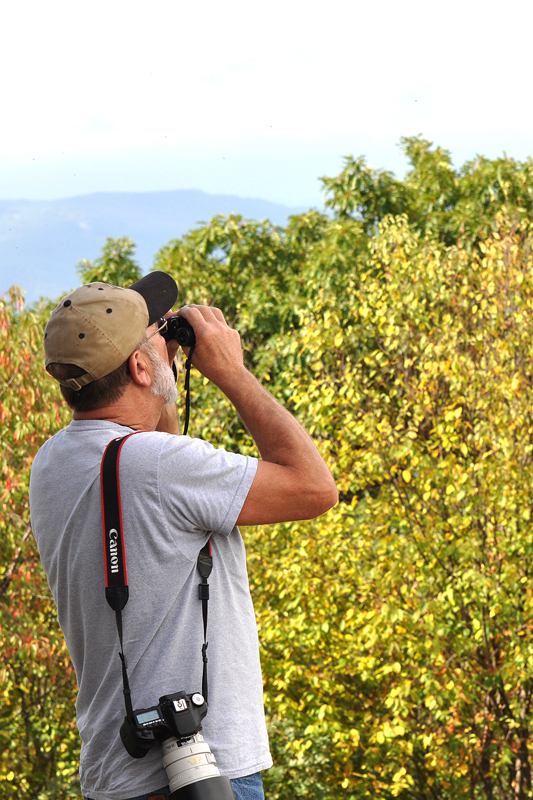
by Ed Kinser
The Poor Mountain birders stand elbow to elbow, binoculars pressed against their eyes and faces aimed toward the sky. “Bird up! Just below the turkey vulture. There’s more! There are five … No, seven! Looks like a kettle. Wow! There have to be at least 75!”
Every fall, birders and nature lovers flock to special points on Appalachian ridges to catch glimpses of migrating raptors. These birds of prey—hawks, falcons, and eagles—use ridge-top routes as they move south for the winter. The raptors follow the long northeast to southwest Appalachian ridges to save energy. After cold fronts move through, west or northwest winds often follow and strike the mountains at an angle. Air currents are deflected up and over the ridge tops, creating aerial interstates along which the raptors may glide for miles without so much as a wing beat. The raptors also find thermals that carry them farther aloft, especially when needing lift to get them out of valleys where they have spent the night, or to get them across valleys that cut swaths across their mountain top passageways.
Without a doubt, the best known raptor viewing site in the U.S. is Pennsylvania’s Hawk Mountain. With hawks being considered vermin before the 1930’s this ridge had been a favorite spot for hunters who practiced their shooting skills and also collected bounties. As conservationists became aware of the massacre, the property was purchased and turned into a sanctuary, with today’s visitors numbering in the thousands.
The best known hotspot for Virginia hawk watchers is Harvey’s Knob Overlook at Milepost 95.5 on the Blue Ridge Parkway. Birders began gathering data at this site in 1975. Now the site is manned from August 15th through the end of November. Last year, the tally of raptors grew to 15,398.
In the fall of 2009 some Bent Mountain birders, who had seen small groups of hawks moving over their plateau community, decided to watch Roanoke County’s Poor Mountain ridge more carefully. This unique ridge is the highest in the county and one of the highest in the area, offering scenic views to birders and good updrafts for raptors. The birders were rewarded by hitting two great days of peak migration of broad-winged hawks, and in those two days alone, were able to count 2976 raptors. As a result of this significant total, the crest of Poor Mountain has been added to hawk migration sites listed by the Hawk Migration Association of North America (www.hmana.org). In addition, the 3.2 miles of mountain top gravel road have been added to Virginia’s Birding and Wildlife Trail System as the Poor Mountain Ridgeline Drive, which on “poor” hawk days, gives birders a chance to look for rare, high elevation species.
Though migration may start in late August, it is usually the last half of September that finds groups of birders out on ridges with a view. This is when the broad-winged hawks from the forested regions of Eastern Canada and the U.S. form flocks called kettles and start their southward migration, heading for South America. For most nature-lovers, seeing a hand full of hawks in a day is a notable event. But when the broad-wings come through, it is possible to see kettles of 50, 75, 100, or even several hundred. Interspersed between the broad-wing kettles are other species of raptors. The common bird hawks are sharp-shinned hawks and Cooper’s hawks from a group of raptors called accipiters. Three species of falcons commonly migrate through Southwest Virginia—kestrels, merlins, and peregrine falcons. There are also ospreys and northern harriers, as well as red-tailed and red-shouldered hawks – and the largest raptors of all, bald eagles and the rare golden eagle.
As of September 29th, the raptors counted just this fall passing along Poor Mountain include: 7 ospreys, 9 bald eagles, 5 northern harriers, 12 sharp-shinned hawks, 5 Cooper’s hawks, 5 red-shouldered hawks, 2937 broad-winged hawks, 19 red-tailed hawks, 12 kestrels, 2 merlins, and 6 peregrine falcons, for a total of 3019 raptors. Though this total may not grow appreciably, the Poor Mountain hawk watchers are still counting, hoping to add to their total and perhaps to even catch a glimpse of a rough-legged hawk or even a golden eagle. Some days the counting is slow, and the winds can cut to the bone, but the sight of each soaring raptor makes the discomfort more tolerable when the bird’s passage is duly recorded in the growing list.


